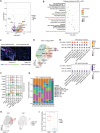Dissecting the Distinct Tumor Microenvironments of HRD and HRP Ovarian Cancer: Implications for Targeted Therapies to Overcome PARPi Resistance in HRD Tumors and Refractoriness in HRP Tumors
- PMID: 39136172
- PMCID: PMC11481286
- DOI: 10.1002/advs.202309755
Dissecting the Distinct Tumor Microenvironments of HRD and HRP Ovarian Cancer: Implications for Targeted Therapies to Overcome PARPi Resistance in HRD Tumors and Refractoriness in HRP Tumors
Abstract
High-grade serous tubo-ovarian cancer (HGSTOC) is an aggressive gynecological malignancy including homologous recombination deficient (HRD) and homologous recombination proficient (HRP) groups. Despite the therapeutic potential of poly (ADP-ribose) polymerase inhibitors (PARPis) and anti-PDCD1 antibodies, acquired resistance in HRD and suboptimal response in HRP patients necessitate more precise treatment. Herein, single-cell RNA and single-cell T-cell receptor sequencing on 5 HRD and 3 HRP tumors are performed to decipher the heterogeneous tumor immune microenvironment (TIME), along with multiplex immunohistochemistry staining and animal experiments for validation. HRD tumors are enriched with immunogenic epithelial cells, FGFR1+PDGFRβ+ myCAFs, M1 macrophages, tumor reactive CD8+/CD4+ Tregs, whereas HRP tumors are enriched with HDAC1-expressing epithelial cells, indolent CAFs, M2 macrophages, and bystander CD4+/CD8+ T cells. Significantly, customized therapies are proposed. For HRD patients, targeting FGFR1+PDGFRβ+ myCAFs via tyrosine kinase inhibitors, targeting Tregs via anti-CCR8 antibodies/TNFRSF4 stimulation, and targeting CXCL13+ exhausted T cells by blocking PDCD1/CTLA-4/LAG-3/TIGIT are proposed. For HRP patients, targeting indolent CAFs, targeting M2 macrophages via CSF-1/CSF-1R inhibitors, targeting bystander T cells via tumor vaccines, and targeting epithelial cells via HDAC inhibitors. The study provides comprehensive insights into HRD and HRP TIME and tailored therapeutic approaches, addressing the challenges of PARPi-resistant HRD and refractory HRP tumors.
Keywords: HRD; HRP; high grade tubo‐ovarian cancer; precise treatment strategies; single‐cell RNA sequencing; single‐cell T cell receptor sequencing; tumor immune microenvironment.
© 2024 The Author(s). Advanced Science published by Wiley‐VCH GmbH.
Conflict of interest statement
The authors declare no conflict of interest.
Figures







References
-
- Sung H., Ferlay J., Siegel R. L., Laversanne M., Soerjomataram I., Jemal A., Bray F., Ca‐Cancer J. Clin. 2021, 71, 209. - PubMed
-
- Lheureux S., Braunstein M., Oza A. M., Ca‐Cancer J. Clin. 2019, 69, 280. - PubMed
-
- Coleman R. L., N. Engl. J. Med. 2020, 382, 686. - PubMed
-
- Miller R. E., Leary A., Scott C. L., Serra V., Lord C. J., Bowtell D., Chang D. K., Garsed D. W., Jonkers J., Ledermann J. A., Nik‐Zainal S., Ray‐Coquard I., Shah S. P., Matias‐Guiu X., Swisher E. M., Yates L. R., Ann. Oncol. Off. J. Eur. Soc. Med. Oncol. 2020, 31, 1606. - PubMed
MeSH terms
Substances
Grants and funding
- 81971361/National Natural Science Foundation of China
- 82173188/National Natural Science Foundation of China
- 2019-01-07-00-07-E00050/Shanghai Education Commission's Research and Innovation Plan
- 21Y11906900/Medical Innovation Research of Shanghai Science and Technology
- 2021YFC2701400/Key Technologies Research and Development Program
- 22Y31900500/Science and Technology Innovation Plan Of Shanghai Science and Technology Commission
- SHDC2020CR1045B/Shanghai Municipal Hospital Development Center
- SHDC2020CR6009/Shanghai Municipal Hospital Development Center
- HDC2020CR4087/Shanghai Municipal Hospital Development Center
- andSHDC22021307/Shanghai Municipal Hospital Development Center
LinkOut - more resources
Full Text Sources
Medical
Research Materials
Miscellaneous
